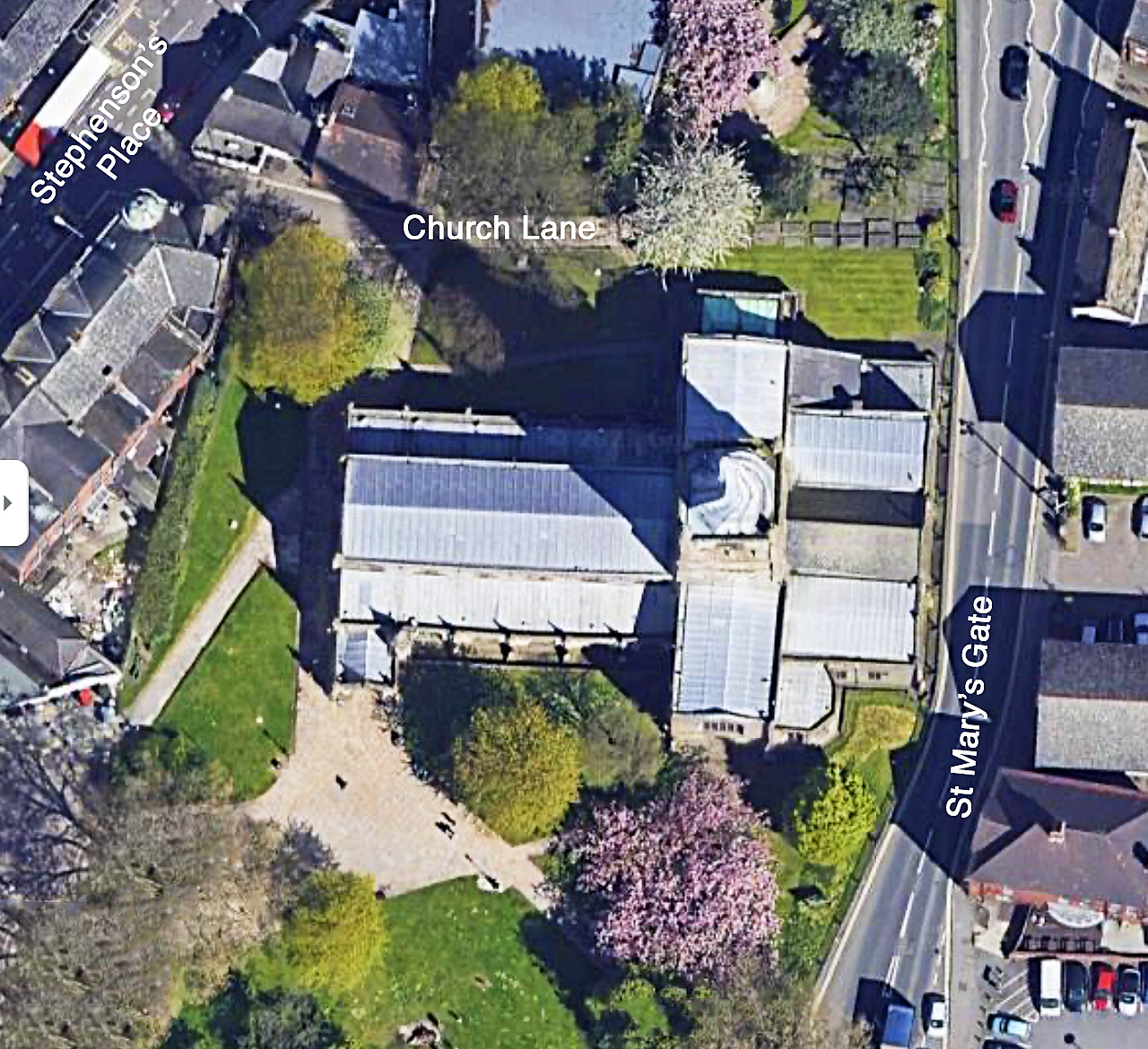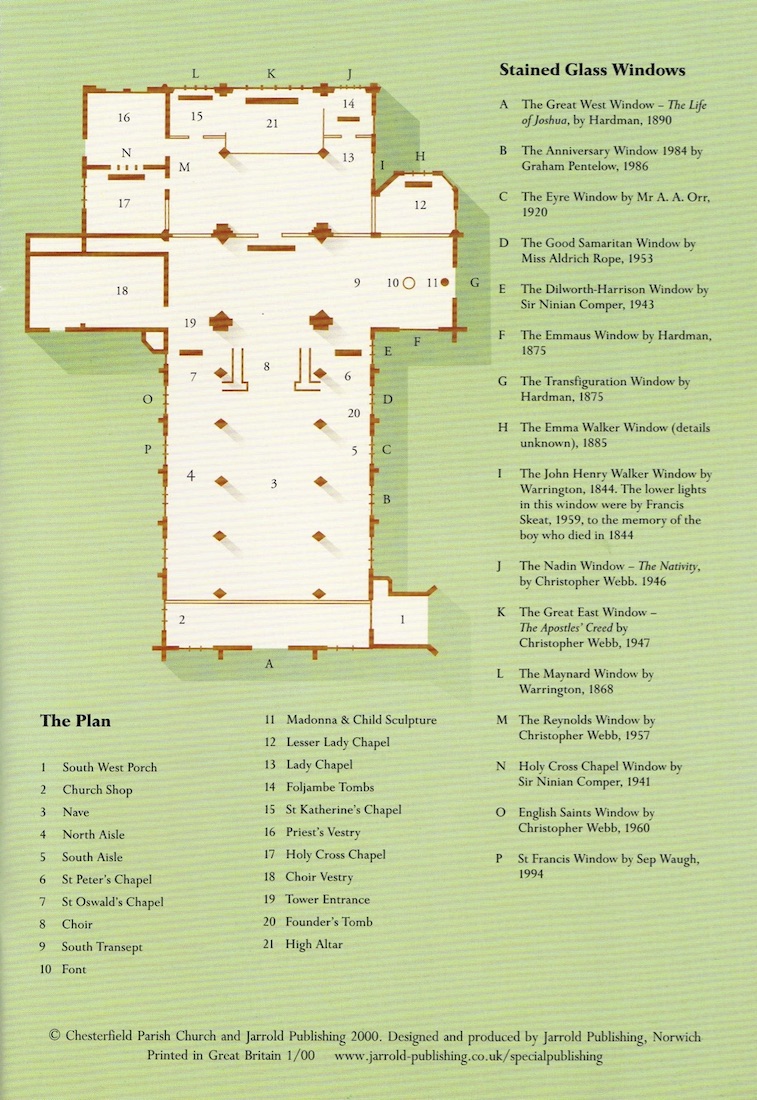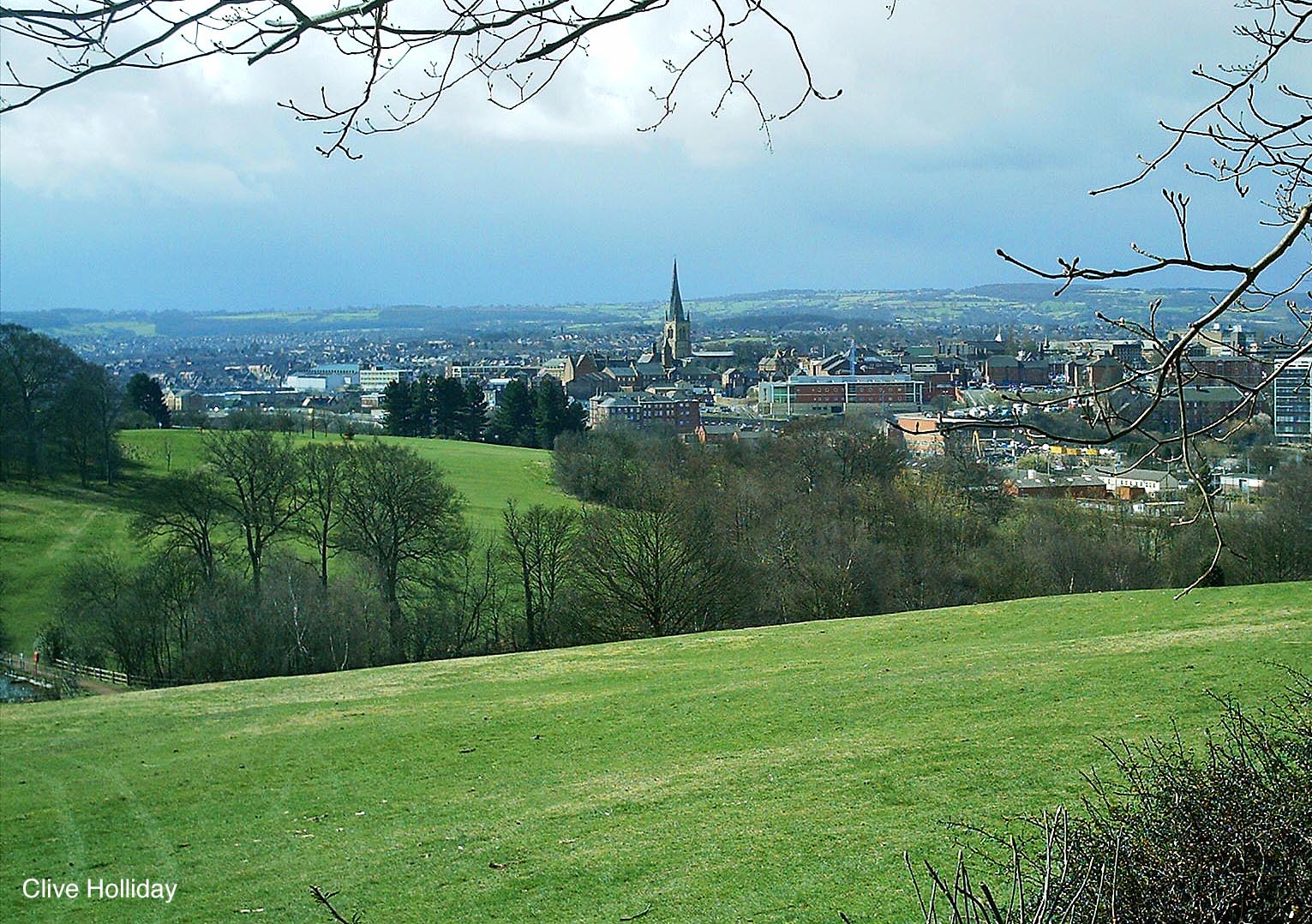There are two main contributors of photographs to this site, but photographs from many others as well. Thank you all for your ready involvement in allowing me to use your photographs here. I have been particularly impressed with the excellence of many of the photographs on this site. A complete list of contributors is given in the Conclusion. Initials at the beginning of each section will indicate who supplied the photograph. Examples are PM for Philip McIver and J&J for ‘Jules and Jenny’.
The spire of the Crooked Spire Church must be the most photographed feature of the town of Chesterfield, but the rest of the Church of St Mary and All Saints is very interesting too.
A brief history of this Church is given below. However, if you want to begin your tour of the Church immediately, tap / click on START . You can also access intermediate points in the tour by a tap / click on the following links:
NOTE ON MAGNIFYING IMAGES
With this website format the images are large enough for most purposes. If there is a need for greater magnification of an image, go to the identical photo on the appropriate website listed in the Conclusion.
SATELLITE VIEW Go
The Church is only a short distance from the Chesterfield railway station. Crown Lane leads to a pedestrian overpass across the busy A61 Rother Way, and then Corporation Street leads directly to the Church. The crooked spire of the Church beckons us closer!
The Church has an almost exact east-west orientation allowing us to identify our Liturgical directions (East with a capital E) with the geographical directions. The Church is set in a pleasant patch of parkland, except that the East wall is hard against St Mary’s Gate (Road).
The Church has a basic cruciform shape with a central tower rising up from the crossing and bearing the famous spire. A small porch has been added at the Southwest corner of the nave (the Southwest porch), and the North transept has been extended slightly. There have been more radical additions at the East end with a row of three main chapels across, a further smaller chapel to the Northeast, and a small rounded chapel to the Southeast.
We shall start our investigation near the Southwest porch (bottom left), follow around the outside of the Church in an anticlockwise direction, and then enter by the Southwest porch.


PLAN CS
This is the plan from the official Church guide, and it contains a great deal of useful information.
We shall visit every marked destination, except for the priest’s vestry (16) and the choir vestry (18), although not in the given order.
We notice the map was printed in the year 2000, and there have been a few changes. So during our visit, the Madonna and Child sculpture (11) had been relocated to the Lesser Lady Chapel (12). Some alterations have been made to the Holy Cross Chapel (17) too. The Chapel doorway shown on the Plan has been filled in, and the West (bottom) wall removed. Now access to the Chapel is via the end of the old North-South aisle.
HISTORY
Year Built: c.1350
Address: Church Way, Chesterfield, UK
Simon Jenkins’ Rating: ***
55 Major British Churches: √
The church is largely medieval with Early English, Decorated Gothic and Perpendicular Gothic features built of ashlar. It comprises a nave, aisles, north and south transepts and the chancel which is surrounded by four guild chapels.
The north transept was rebuilt in 1769 and George Gilbert Scott carried out a restoration in 1843, when a new ceiling was installed and a new east window inserted with stained glass by William Wailes of Newcastle. A new font was donated by Samuel Johnson of Somersal Hall. The church reopened on 9 May 1843.
On 11 March 1861 the church spire was struck by lightning, which snapped the gas lighting pipes in the tower, starting a fire in a beam next to the wooden roof of the chancel. The fire smouldered for three and a half hours until it was discovered by the Sexton on his nightly round to ring the midnight bell.
A further restoration was begun in 1896 by Temple Lushington Moore. Moore designed the High Altar reredos, installed in 1898.
A fire on 22 December 1961 destroyed many of the interior fittings, including the Snetzler organ. Surviving elements include the south transept screen from ca 1500, the Norman font and a Jacobean pulpit.
The spire was added in the 14th-century tower in about 1362, and is 228 feet (69 m) high from the ground. It is both twisted and leaning, twisting 45 degrees and leaning 9 ft 6 in (2.9 m) from its true centre. The leaning characteristic was initially suspected to be the result of the absence of skilled craftsmen (the Black Death had been gone only twelve years before the spire’s completion), insufficient cross bracing, and the use of unseasoned timber.
It is now believed that the twisting of the spire was caused by the lead that covers the spire. The lead causes this twisting phenomenon, because when the sun shines during the day the south side of the tower heats up, causing the lead there to expand at a greater rate than that of the north side of the tower, resulting in unequal expansion and contraction. This was compounded by the weight of the lead (approximately 33 tonnes) which the spire’s bracing was not originally designed to bear. Using unseasoned wood could have contributed to a smaller extent. As wood seasons, or dries, it twists and distorts. Although this distortion is generally accounted for in the construction process, distortion still occurs and varies depending on the type of lumber used and how it is cut.
The cockerel weather vane on top of the spire is inscribed with the names of the past vicars of St Mary’s.
In common folklore, there are numerous explanations as to why the spire is twisted. One well-established legend goes that a virgin once married in the church, and the church was so surprised that the spire turned around to look at the bride, and continues that if another virgin marries in the church, the spire will return to true again. Several local legends hold that the Devil was responsible. In one tale, a Bolsover blacksmith mis-shod the Devil, who leapt over the spire in pain, knocking it out of shape. A similar story has the Devil causing mischief in Chesterfield, seating himself on the spire and wrapping his tail around it. The people of the town rang the church bells and the Devil, frightened by the clamour, tried to jump away with his tail still wound about the spire, causing it to twist. A similar tale argues that the Devil was flying from Nottingham to Sheffield and stopped on top of the spire. He then did a violent sneeze that caused the spire to twist.
The tower upon which the spire sits contains ten bells. These bells were cast in 1947 by the Whitechapel Bell Foundry in London, replacing a previous ring. The heaviest weighs 1,270 kg (25 cwt). The place in which the bells are situated once held the builders’ windlass, which is one of the few examples of a medieval crane in existence and is the only example of one that has survived from a parish church. The windlass is now on display at Chesterfield Museum and Art Gallery.
It is this twisted spire that gives the town’s football club, Chesterfield F.C., their nickname, ‘the Spireites’. A depiction of the spire also features on the club’s crest.
https://en.wikipedia.org/wiki/Church_of_St_Mary_and_All_Saints,_Chesterfield
St Mary’s is famous for its peculiar 13th century twisted spire, which leans at an alarming 9 feet 5 inches from true.
...
While you are standing in the churchyard gazing at the crooked spire, look for an old 1924 gas lamp, which once illuminated the nearby market place.
Inside the church you find yourself passing under a massive west gallery to reach the light, spacious nave. There are north and south aisles and transepts, and the chancel with 4 guild chapels surrounding it. Though much of the interior dates to the 14th century, it was comprehensively rebuilt in 1843 by Sir George Gilbert Scott, and again in 1896 by Temple Moore who installed the striking reredos behind the high altar.
Historic features include the Jacobean pulpit, a Norman font, and a late 15th-century wooden screen in the south transept. Look for a window on the south aisle wall depicting scenes from the history of Chesterfield. Also in the south aisle is a medieval tomb niche with the effigy of an unknown woman, her hands clasped in prayer.
In the south transept is a parish chest, bound by iron straps, created around 1600. Also in the transept is a beautiful 17th century long case clock, its case embellished with detailed carvings including a Crucifixion scene, foliage, and, appropriately for a clock, the figure of a cockerel.
Beyond the screen, in the southernmost chapel, is a pair of brass chandeliers dated to 1760. Also in the southernmost chapel is a wonderful array of 16th and 17th century memorials to the local Foljambe family.
In the north transept is part of an original 1475 rood screen.
On the north side of the churchyard is the grave of Francois Raingeard, a French officer during the Napoleonic Wars. Raingeard was held prisoner in Chesterfield, and died before the war ended. He was buried in St Mary’s churchyard, under a gravestone inscribed in English, French, and Latin.
St Mary’s is a wonderful historic church, full of interest even without the famous spire.
https://www.britainexpress.com/counties/derbyshire/churches/chesterfield.htm



